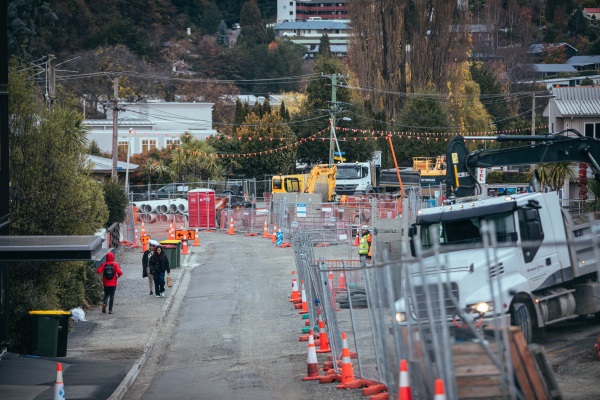Queenstown’s council’s just voted to sink another $16.65 million into the stage 1 arterial road.
At their meeting this afternoon, councillor Niki Gladding voted against the motion.
It was revealed earlier this week the Alliance need the money from council coffers because they don’t have enough money to finish it off.
Had councillors refused, the Melbourne-Henry St link was likely to remain unfinished and unusable, and Beetham, Ballarat and Malaghan Sts all incomplete and closed, even to rubbish trucks.
It’s the second request the Alliance has made for more money in less than a year.
This afternoon’s decision means, the total budget for the project, which is receiving $50m from Crown Infrastructure Partners, will
increase to $128.02m.
Initially pegged to cost $49.5m, that jumped to $88.23m in October, 2021, and then to $108.84m last April following a public-excluded council meeting.
Council’s ‘owner interface manager’ Geoff Mayman says there was a second lift last year, to $110.37m, through the ‘‘annual process’’.
Before today’s meeting, Queenstown mayor Glyn Lewers told Mountain Scene he’s not surprised the Alliance has come back to ask for more ‘‘because they did forewarn us’’.
He does have questions, though, which will be covered in the ‘‘Alliance review’’.
They include how often and how they monitored the cost to complete.

Given the road’s due to be open and operational by Christmas Eve, and fully finished by March 31 next year, is Lewers confident this will be the last time the Alliance knocks on the door with its hand out?
‘‘I certainly hope so.
‘‘I am hopeful this is the last time, and those questions will certainly be asked.”
He’s less hopeful the proposed second and third stages — ultimately creating a ring road around the CBD, terminating at the existing Fernhill roundabout — will progress in the next five or 10 years.
While there may be some ‘‘alternative funding arrangements’’ which arise, ‘‘they could probably understand council might be a little bit gun-shy engaging with those, given the experience we’ve had with this project’’.
Lewers, though, believes the Alliance model was ‘‘probably the best procurement method available to us with regards to a project of this scale’’.
The arterial came with a lot of unknowns, largely around underground services, which had resulted in extra complexity and cost.
Costs also increased due to sharp increases in the cost of civil materials and labour, spawned largely by Covid.
He notes, too, due to the way the contract works, the profit margin on the project is a ‘‘win-win, lose-lose’’ for the Alliance and its partners, council and NZ Transport Agency Waka Kotahi.
Because the project had gone over the estimated total base cost, the profit margin had disappeared, meaning the Alliance has ‘‘lost all their profit’’.
‘‘This idea they’re on charge-up and they’ve got incentives to go slow … that’s incorrect,’’ he says.
‘‘It’s all just on a cost basis with no profit margin for the Alliance.
‘‘There is no win for them.
‘‘There is an incentive to go faster, because they’re chewing up resource for other stuff, opportunity cost projects.
‘‘They’re just getting money to complete the job, there is no profit for them.’’
Don’t hit your head …
Lewers says the $16.65 million needed to complete the stage 1 arterial road, will be debt-funded.
To be largely serviced from the Whakatipu roading rate, top-ups will come from the Whakatipu stormwater rate and Queenstown water supply and wastewater rates.
As to any potential negative impacts for ratepayers of that, Lewers says because of the debt ceiling, councillors will have to adjust the timing of a few projects coming in year one of the long-term plan (LTP).
That debt ceiling’s 280% of net debt versus income.
As to where Queenstown’s council is?
‘‘We’re probably looking, depending on how council decides on the LTP, between 250% and 260%.
‘‘We are getting up there, but this is not uncommon with high-growth councils and, as you’re well aware, we’re the fastest-growing [district] in New Zealand.
‘‘This is mainly driven by providing infrastructure for the growth that we have,’’ Lewers says.




